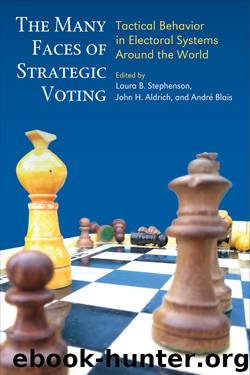The Many Faces of Strategic Voting: Tactical Behavior in Electoral Systems Around the World by Laura B. Stephenson & John H. Aldrich & André Blais

Author:Laura B. Stephenson & John H. Aldrich & André Blais
Language: eng
Format: epub
Publisher: The University of Michigan Press
Published: 2018-05-15T00:00:00+00:00
Empirical Findings at the Aggregate Level
The aggregate-level analysis proceeds in two steps employing a multinomial treatment-effects model (Deb and Trivedi 2006).11
First Stage: Model Setup
The dependent variable in the first stage is the treatment effect: whether the district has no challenger of quality or more than one compared to the control group, where there is only one challenger of quality. Which factors affect the quality and the number of quality candidates in a district? The first factor is the vote share margin between the SMD winner and the runner-up in the previous election (PrevMargin): the larger the values of the PrevMargin variable, the less competitive the district is and the less likely it is that challenger parties will enter the race and waste strong candidates. Since the competitiveness in the previous election is needed to calculate this variable, the first postreform election (1996) cannot be included in the empirical models.12 The second factor takes into account Japanese parties’ capacity to nominate slates of qualified candidates for SMDs. Because of its historic dominance and many incumbents, the LDP is best situated to locate high-quality candidates with strong local support. For this reason, I include a dummy variable in the model for the presence or absence of an LDP incumbent (LDPincumbent), which should scare away strong opponents. Third, voters’ incentives to coordinate strategically are known to be affected by elites’ coordination. Hence, the third factor included in the model is a dummy variable that measures, at the district level, whether the opposition (to the LDP) has coordinated around a strong Democratic Party of Japan candidate.13 Coordination by the opposition increases the chances of a quality challenger but reduces the chances of more than one. Finally, the fourth factor is the number of candidates who contested the district in the previous election (PrevNcands), which is likely to affect the dependent variable: the larger the number of previous candidates, the more likely that more than one quality challenger will arise and the less likely that only a single quality candidate will arise.
Download
This site does not store any files on its server. We only index and link to content provided by other sites. Please contact the content providers to delete copyright contents if any and email us, we'll remove relevant links or contents immediately.
American Kingpin by Nick Bilton(3510)
Future Crimes by Marc Goodman(3374)
The Meaning of the Library by unknow(2386)
Inside the Middle East by Avi Melamed(2233)
Why Nations Fail: The Origins of Power, Prosperity, and Poverty by Daron Acemoglu & James Robinson(2176)
On Tyranny by Timothy Snyder(2127)
Living Silence in Burma by Christina Fink(1982)
Putin's Labyrinth(1902)
The Mastermind by Evan Ratliff(1830)
The Smartest Kids in the World by Amanda Ripley(1686)
Think Like a Rocket Scientist by Ozan Varol(1677)
Law: A Very Short Introduction by Raymond Wacks(1636)
It's Our Turn to Eat by Michela Wrong(1593)
The Rule of Law by Bingham Tom(1593)
Leadership by Doris Kearns Goodwin(1563)
Philosophy of law a very short introduction by Raymond Wacks(1542)
A Dirty War by Anna Politkovskaya(1542)
Social Media Law in a Nutshell by Ryan Garcia & Thaddeus A Hoffmeister(1451)
Civil Procedure (Aspen Casebooks) by Stephen C. Yeazell(1440)
